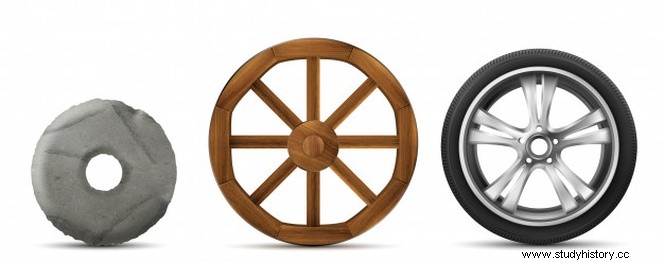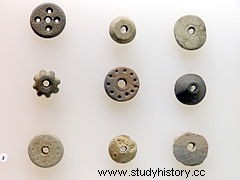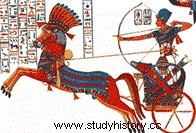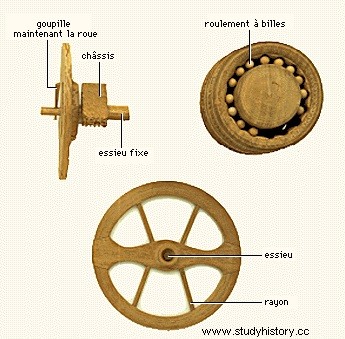 Around 3500 BC, the sumerians used logs to move heavy stones. They then had the idea of making a hole in the center of a round shape and placing an axle there:this was the invention of the wheel , on which our whole civilization will be built. The wheels were initially solid structures but they gradually evolved into a lighter and stronger model with spokes. The wheel assumes animal traction, as well as a terrain suitable for rolling. It was therefore not a sudden discovery but the result of the meeting of several factors.
Around 3500 BC, the sumerians used logs to move heavy stones. They then had the idea of making a hole in the center of a round shape and placing an axle there:this was the invention of the wheel , on which our whole civilization will be built. The wheels were initially solid structures but they gradually evolved into a lighter and stronger model with spokes. The wheel assumes animal traction, as well as a terrain suitable for rolling. It was therefore not a sudden discovery but the result of the meeting of several factors.
Circular objects from prehistory
The circular shape is not a human creation, since it exists in nature. Circular objects abound in nature:animal eyes, stars, circles in water, fruits, etc.; but also in culture, with the round huts, or when Homo sapiens, some 30,000 years ago, was already whirling diamond-shaped bone objects called "rhombs" at the end of a rope, to produce strident sounds - they are among the oldest musical instruments, still used in Papua and Australia. Further still, the rotary movement, between the two hands, of a piece of wood against another piece of wood made it possible to produce fire by heating.
 This same vertical rotary method, perfected by the use of a bow, or even a flywheel, will be in use during recent periods of prehistory to perforate beads or pendants, for example. With the domestication of the sheep and the exploitation of the wool is born a close and doubly circular object, the weighted spindle of a circular wheel of inertia, fixed in its lower part and called "fusaïole":the spinner or the spinner braids with the gradually between his fingers the strands of raw wool into a continuous thread, wound at the same time around the rotating spindle. These spindle whorls, in stone and especially in baked clay, are therefore the oldest known wheels, certainly small in size but already equipped with a transverse axis. They are attested in Europe from the 5th millennium BC.
This same vertical rotary method, perfected by the use of a bow, or even a flywheel, will be in use during recent periods of prehistory to perforate beads or pendants, for example. With the domestication of the sheep and the exploitation of the wool is born a close and doubly circular object, the weighted spindle of a circular wheel of inertia, fixed in its lower part and called "fusaïole":the spinner or the spinner braids with the gradually between his fingers the strands of raw wool into a continuous thread, wound at the same time around the rotating spindle. These spindle whorls, in stone and especially in baked clay, are therefore the oldest known wheels, certainly small in size but already equipped with a transverse axis. They are attested in Europe from the 5th millennium BC.
A final rotary technique, although not archaeologically attested for the most remote periods, remains probable:the use of logs to move heavy loads, and in particularly the huge stone slabs, weighing several tens of tons, megalithic funerary monuments or "dolmens". Some are dated in Europe to the end of the 5th millennium.
The invention of the wheel
Man has adapted this circular shape since prehistoric times to build his huts, to imagine musical instruments or tools using circular movement. In the field of transport, it is likely that men used logs to move heavy loads such as cut stones or megaliths. With the development of agriculture and the domestication of wild animals, animal traction made its appearance with the plow (without wheel).
 The oldest known wheels, made in ancient Mesopotamia, date from around 3500 to 3000 BC. It would seem that wheeled wooden carts appeared after the invention of the potter's wheel and that the wheeled cart quickly supplanted the sled as a means of transport. In its simplest form, the wheel was a solid wooden disc mounted on a round axle, to which it was attached by wooden pegs.
The oldest known wheels, made in ancient Mesopotamia, date from around 3500 to 3000 BC. It would seem that wheeled wooden carts appeared after the invention of the potter's wheel and that the wheeled cart quickly supplanted the sled as a means of transport. In its simplest form, the wheel was a solid wooden disc mounted on a round axle, to which it was attached by wooden pegs.
Subsequently, certain parts were hollowed out to reduce their weight and the spokes were invented around 2000 BC. J.-C. The spoked wheel, lighter, allows much higher speeds. This last innovation led to the invention of the chariot, for example in Egypt, used for hunting, for parade, and of course on the battlefields where it sowed chaos among enemy infantry.
Spoke wheels will endure to the present day, benefiting from regular improvements, such as metal strapping in the Iron Age, and much later rubber tires or the replacing wood with metal. Animal power is gradually disappearing in favor of motors - the human force remaining required for the bicycle, the rickshaw, the wheelbarrow... The wheel required the development of regular and paved paths from Roman times .
Distribution and use of the wheel
After the Near East and the Eastern Mediterranean, the wheel spread rapidly throughout Eurasia, from China to the Celtic world, as long as environmental conditions were suitable. . Such vehicles, or at least their wheels, have been found in certain graves of the so-called "pit tomb" culture in Ukraine and southern Russia, in which the most important figures were buried in pits covered with a mound of earth and stone.
 Wheels have also been unearthed in the mud of alpine lakes. There are representations of it in the form of small clay models deposited in the tombs of the Baden culture, in Hungary, of engravings as on the pot of Bronocice, in Poland, or rock engravings. Traces of 5,000-year-old wheels have even been discovered in France, at Jaunay-Clan, in Vienne.
Wheels have also been unearthed in the mud of alpine lakes. There are representations of it in the form of small clay models deposited in the tombs of the Baden culture, in Hungary, of engravings as on the pot of Bronocice, in Poland, or rock engravings. Traces of 5,000-year-old wheels have even been discovered in France, at Jaunay-Clan, in Vienne.
In pre-Columbian America, the rugged terrain, abundant vegetation and absence of draft animals did not make this innovation relevant. Elsewhere, the wheel finds many applications, from spinning wheel to paddle wheel for mounis, norias for irrigation and cogwheels for many mechanisms.
The invention of the wheel was an essential step in technological progress:it revolutionized the means of transport and communication; it heralded the era of modern machinery; it allowed a more efficient use of animal traction in agriculture by becoming an irreplaceable mechanical means of directional regulation of forces. It also made possible the use of new systems of transmission and demultiplication of forces. The applications of the wheel in modern society and technology are virtually limitless.
To go further
- The Fabulous History of Inventions - From mastery of fire to immortality. Dunod, 2018.
- Short stories of transport:Or how the means of transport have evolved since their invention, by Pierre LEFEVRE. bayard, 2014.
